[English] 日本語
 Yorodumi
Yorodumi- PDB-7n9b: Potent neutralizing nanobodies resist convergent circulating vari... -
+ Open data
Open data
- Basic information
Basic information
| Entry | Database: PDB / ID: 7n9b | ||||||||||||
|---|---|---|---|---|---|---|---|---|---|---|---|---|---|
| Title | Potent neutralizing nanobodies resist convergent circulating variants of SARS-CoV-2 by targeting novel and conserved epitopes-CovS with NB21 | ||||||||||||
 Components Components |
| ||||||||||||
 Keywords Keywords | VIRAL PROTEIN/IMMUNE SYSTEM / CovS NB21 nanobody / VIRAL PROTEIN / VIRAL PROTEIN-IMMUNE SYSTEM complex | ||||||||||||
| Function / homology |  Function and homology information Function and homology informationsymbiont-mediated disruption of host tissue / Maturation of spike protein / Translation of Structural Proteins / Virion Assembly and Release / host cell surface / host extracellular space / viral translation / symbiont-mediated-mediated suppression of host tetherin activity / Induction of Cell-Cell Fusion / structural constituent of virion ...symbiont-mediated disruption of host tissue / Maturation of spike protein / Translation of Structural Proteins / Virion Assembly and Release / host cell surface / host extracellular space / viral translation / symbiont-mediated-mediated suppression of host tetherin activity / Induction of Cell-Cell Fusion / structural constituent of virion / membrane fusion / entry receptor-mediated virion attachment to host cell / Attachment and Entry / host cell endoplasmic reticulum-Golgi intermediate compartment membrane / positive regulation of viral entry into host cell / receptor-mediated virion attachment to host cell / host cell surface receptor binding / symbiont-mediated suppression of host innate immune response / receptor ligand activity / endocytosis involved in viral entry into host cell / fusion of virus membrane with host plasma membrane / fusion of virus membrane with host endosome membrane / viral envelope / symbiont entry into host cell / virion attachment to host cell / SARS-CoV-2 activates/modulates innate and adaptive immune responses / host cell plasma membrane / virion membrane / identical protein binding / membrane / plasma membrane Similarity search - Function | ||||||||||||
| Biological species |   | ||||||||||||
| Method | ELECTRON MICROSCOPY / single particle reconstruction / cryo EM / Resolution: 3.8 Å | ||||||||||||
 Authors Authors | Sun, D. / Zhang, C. / Shi, Y. | ||||||||||||
| Funding support |  United States, 3items United States, 3items
| ||||||||||||
 Citation Citation |  Journal: bioRxiv / Year: 2021 Journal: bioRxiv / Year: 2021Title: Potent neutralizing nanobodies resist convergent circulating variants of SARS-CoV-2 by targeting novel and conserved epitopes. Authors: Dapeng Sun / Zhe Sang / Yong Joon Kim / Yufei Xiang / Tomer Cohen / Anna K Belford / Alexis Huet / James F Conway / Ji Sun / Derek J Taylor / Dina Schneidman-Duhovny / Cheng Zhang / Wei Huang / Yi Shi /   Abstract: There is an urgent need to develop effective interventions resistant to the evolving variants of SARS-CoV-2. Nanobodies (Nbs) are stable and cost-effective agents that can be delivered by novel ...There is an urgent need to develop effective interventions resistant to the evolving variants of SARS-CoV-2. Nanobodies (Nbs) are stable and cost-effective agents that can be delivered by novel aerosolization route to treat SARS-CoV-2 infections efficiently. However, it remains unknown if they possess broadly neutralizing activities against the prevalent circulating strains. We found that potent neutralizing Nbs are highly resistant to the convergent variants of concern that evade a large panel of neutralizing antibodies (Abs) and significantly reduce the activities of convalescent or vaccine-elicited sera. Subsequent determination of 9 high-resolution structures involving 6 potent neutralizing Nbs by cryoelectron microscopy reveals conserved and novel epitopes on virus spike inaccessible to Abs. Systematic structural comparison of neutralizing Abs and Nbs provides critical insights into how Nbs uniquely target the spike to achieve high-affinity and broadly neutralizing activity against the evolving virus. Our study will inform the rational design of novel pan-coronavirus vaccines and therapeutics. | ||||||||||||
| History |
|
- Structure visualization
Structure visualization
| Movie |
 Movie viewer Movie viewer |
|---|---|
| Structure viewer | Molecule:  Molmil Molmil Jmol/JSmol Jmol/JSmol |
- Downloads & links
Downloads & links
- Download
Download
| PDBx/mmCIF format |  7n9b.cif.gz 7n9b.cif.gz | 568.3 KB | Display |  PDBx/mmCIF format PDBx/mmCIF format |
|---|---|---|---|---|
| PDB format |  pdb7n9b.ent.gz pdb7n9b.ent.gz | 450.4 KB | Display |  PDB format PDB format |
| PDBx/mmJSON format |  7n9b.json.gz 7n9b.json.gz | Tree view |  PDBx/mmJSON format PDBx/mmJSON format | |
| Others |  Other downloads Other downloads |
-Validation report
| Summary document |  7n9b_validation.pdf.gz 7n9b_validation.pdf.gz | 1 MB | Display |  wwPDB validaton report wwPDB validaton report |
|---|---|---|---|---|
| Full document |  7n9b_full_validation.pdf.gz 7n9b_full_validation.pdf.gz | 1.1 MB | Display | |
| Data in XML |  7n9b_validation.xml.gz 7n9b_validation.xml.gz | 87.9 KB | Display | |
| Data in CIF |  7n9b_validation.cif.gz 7n9b_validation.cif.gz | 134.3 KB | Display | |
| Arichive directory |  https://data.pdbj.org/pub/pdb/validation_reports/n9/7n9b https://data.pdbj.org/pub/pdb/validation_reports/n9/7n9b ftp://data.pdbj.org/pub/pdb/validation_reports/n9/7n9b ftp://data.pdbj.org/pub/pdb/validation_reports/n9/7n9b | HTTPS FTP |
-Related structure data
| Related structure data |  24255MC  7n9aC  7n9cC  7n9eC M: map data used to model this data C: citing same article ( |
|---|---|
| Similar structure data |
- Links
Links
- Assembly
Assembly
| Deposited unit | 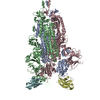
|
|---|---|
| 1 |
|
- Components
Components
| #1: Protein | Mass: 152312.750 Da / Num. of mol.: 3 Source method: isolated from a genetically manipulated source Details: Pre-fusion stabilized HexaPro construct, including six proline substitutions and furin cleavage site RRAR 682-685 mutated to GSAS Source: (gene. exp.)  Gene: S, 2 / Production host:  Homo sapiens (human) / References: UniProt: P0DTC2 Homo sapiens (human) / References: UniProt: P0DTC2#2: Protein | Mass: 15770.573 Da / Num. of mol.: 2 Source method: isolated from a genetically manipulated source Source: (gene. exp.)   Has protein modification | Y | |
|---|
-Experimental details
-Experiment
| Experiment | Method: ELECTRON MICROSCOPY |
|---|---|
| EM experiment | Aggregation state: PARTICLE / 3D reconstruction method: single particle reconstruction |
- Sample preparation
Sample preparation
| Component |
| ||||||||||||||||||||||||
|---|---|---|---|---|---|---|---|---|---|---|---|---|---|---|---|---|---|---|---|---|---|---|---|---|---|
| Molecular weight | Experimental value: NO | ||||||||||||||||||||||||
| Source (natural) |
| ||||||||||||||||||||||||
| Source (recombinant) |
| ||||||||||||||||||||||||
| Buffer solution | pH: 7.5 | ||||||||||||||||||||||||
| Specimen | Embedding applied: NO / Shadowing applied: NO / Staining applied: NO / Vitrification applied: YES | ||||||||||||||||||||||||
| Vitrification | Cryogen name: ETHANE |
- Electron microscopy imaging
Electron microscopy imaging
| Experimental equipment |  Model: Titan Krios / Image courtesy: FEI Company |
|---|---|
| Microscopy | Model: FEI TITAN KRIOS |
| Electron gun | Electron source:  FIELD EMISSION GUN / Accelerating voltage: 300 kV / Illumination mode: FLOOD BEAM FIELD EMISSION GUN / Accelerating voltage: 300 kV / Illumination mode: FLOOD BEAM |
| Electron lens | Mode: BRIGHT FIELD |
| Image recording | Electron dose: 60 e/Å2 / Detector mode: COUNTING / Film or detector model: FEI FALCON III (4k x 4k) |
- Processing
Processing
| CTF correction | Type: PHASE FLIPPING AND AMPLITUDE CORRECTION |
|---|---|
| 3D reconstruction | Resolution: 3.8 Å / Resolution method: FSC 0.143 CUT-OFF / Num. of particles: 91000 / Symmetry type: POINT |
 Movie
Movie Controller
Controller





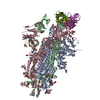
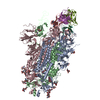
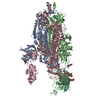
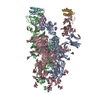
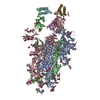
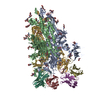
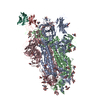


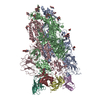
 PDBj
PDBj



